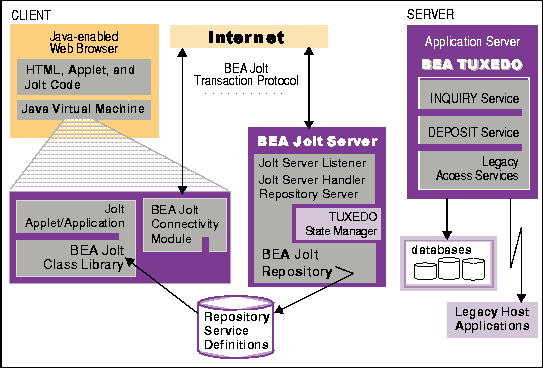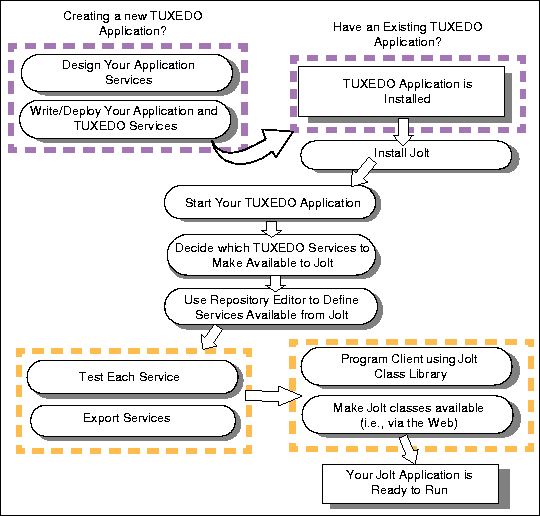The separation of BEA Jolt into these components permits the transactional and Internet components of client/server applications to be implemented separately with the security and scalability required for large-scale Internet and intranet services.
Key Features
With BEA Jolt, you can leverage existing TUXEDO services and extend your transaction environment to the corporate intranet or world-wide Internet. The key feature of the Jolt architecture is its simplicity. Using Jolt, you can build, deploy and maintain robust, modular, and scalable electronic commerce systems that operate over the Internet.
BEA Jolt includes the following features.
Java-based API for Simplified Development. With its Java-based API, BEA Jolt simplifies application design by providing well-designed object interfaces. Jolt supports the Java JDK 1.02 and is fully compatible with Java threads. Jolt enables Java programmers to build graphical front-ends that use the TUXEDO application and transaction services without the need to understand detailed transactional semantics or without having to rewrite existing TUXEDO applications.
Pure Java Client Development. Using Jolt you can build a pure Java client that runs in any Java-enabled browser. Jolt automatically converts from Java to native BEA TUXEDO data types and buffers and from TUXEDO back to Java. As a pure Java client, your applet or application does not need resident client-side libraries or installation, allowing client applications to be downloaded via the network thereby simplifying software distribution.
Easy Access to TUXEDO Services via Jolt Repository. The BEA Jolt Repository facilitates Java application development by managing and presenting BEA TUXEDO service definitions that you can use in your Java client. A Jolt repository bulk loading utility lets you quickly integrate your existing TUXEDO services into the Jolt development environment. Jolt and TUXEDO simplify network and application scalability, while encouraging the reuse of application components.
GUI-based Maintenance and Distribution of TUXEDO Services. The Jolt Repository Editor lets you manage BEA TUXEDO service definitions such as service names, inputs and outputs. The Jolt Repository Editor provides support for different input and output names for services defined in the Jolt Repository.
 Encryption for Secure Transaction Processing. BEA Jolt allows you to encrypt data transmitted between Jolt clients and the JSL/JSH.
Encryption for Secure Transaction Processing. BEA Jolt allows you to encrypt data transmitted between Jolt clients and the JSL/JSH.
When you enable encryption support, Jolt 1.1 uses a combination of DES and RC4 encryption algorithms to encrypt all data that is transmitted between a Jolt client and a Jolt server. DES (56-bit) encryption is used for key exchange and authentication, and RC4 is used for all subsequent data exchanges. Jolt 1.1 features two versions of encryption support: one allows a 128-bit key for data encryption, the other allows a 40-bit key.
The 128-bit version generates a 128-bit RC4 session encryption key at logon time, and this session key is transmitted over the network in a message protected by 56-bit DES encryption. The temporary session key is then used to encrypt the session's data. The overall security level achieved is equivalent to 56-bit DES encryption, even though the data encryption is using a 128-bit key.
Note: The 56/128-bit version of Jolt 1.1 cannot be used outside the United States without proper approval from the United States government.
Jolt encryption addresses the issue of security that is essential for reliable Internet transaction processing.
 Added Security via Internet Relay. BEA Jolt features an Internet Relay component that allows network administrators to separate their Web Server and TUXEDO application server. Web servers are generally considered insecure as they often exist outside a corporate firewall. The Jolt Internet Relay gives you greater flexibility to locate your BEA TUXEDO server in a secure location or environment on your network, yet still be able to handle transactions from Jolt clients on the Internet.
Added Security via Internet Relay. BEA Jolt features an Internet Relay component that allows network administrators to separate their Web Server and TUXEDO application server. Web servers are generally considered insecure as they often exist outside a corporate firewall. The Jolt Internet Relay gives you greater flexibility to locate your BEA TUXEDO server in a secure location or environment on your network, yet still be able to handle transactions from Jolt clients on the Internet.
 Event Subscription Support. Jolt Event Subscription is used to receive event notifications from either TUXEDO services or other TUXEDO clients. Jolt Event Subscription lets you handle two types of TUXEDO application events:
Event Subscription Support. Jolt Event Subscription is used to receive event notifications from either TUXEDO services or other TUXEDO clients. Jolt Event Subscription lets you handle two types of TUXEDO application events:









